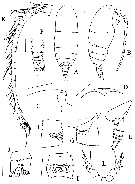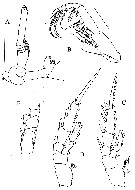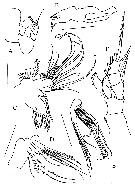|
|
 |
Fiche d'espèce de Copépode |
|
|
Calanoida ( Ordre ) |
|
|
|
Clausocalanoidea ( Superfamille ) |
|
|
|
Scolecitrichidae ( Famille ) |
|
|
|
Brodskius ( Genre ) |
|
|
| |
Brodskius abyssalis Markhaseva & Schulz, 2007 (F) | |
| | | | | | | Ref.: | | | Markhaseva & Schulz, 2007 (p.732, figs.F) |  issued from : E.L. Markhaseva & K. Schulz in J. Nat. Hist., 2007, 41 (13-16). [p.733, Fig.1] Female (from 67°31'S, 0°01'E): A-B, habitus (dorsal and lateral, respectively); C-D, forehead (lateral and ventral, respectively); E, posterior prosome and urosome (left lateral); F, urosome (dorsal; left dorsal seta detached); G, genital double-somite (left lateral); H, idem (right lateral); I, idem (ventral); J, anal somite and caudal rami (ventral); K, A1; L, P5 (posterior). Scale bars: 0.1 mm. Nota : Prosome 4.1 times longer than urosome. Rostrum without filaments. Cephalosome and pediger 1 incompletely separate, 4th and 5th separate. Posterior corners significantly indented in lateral view. Spermathecae oblong-round. Caudal rami with 4 terminal, 1 small dorsal and 1 small ventral setae. A1 24-segmented slightly longer than prosome. P5 uniramous, 3-segmented ; coxae naked and fused by intercoxal sclerite ; basis with small patch of denticles distolaterally ; exopod with denticles on posterior surface, 1 short lateral, 1 moderately long subterminal spine, 1 long terminal unarticulated extension, and 1 long medial spine, all toothed.
|
 issued from : E.L. Markhaseva & K. Schulz in J. Nat. Hist., 2007, 41 (13-16). [p.734, Fig.2] Female: A, A2; B, Mxp; C, P2 (posterior); D, P3 (posterior); E, P4 (posterior, endopod and exopod incomplete). Scale bars: 0.1 mm. Nota : A2 : endopodal segment 1 with 1 seta, 2nd segment with 12 setae ; exopod 7-segmented with 0 , 2, 1, 1, 1, 1, and 3 setae. Mxp : syncoxa without seta on proximal praecoxal endite, 2 setae on middle endite, 3 setae on distal endite ; coxal endite with 3 setae ; basis with 3 medial, 2 distal setae and row of denticles proximally ; endopod of 5 segments with 4, 3, 2, 2+1 and 4 setae.
|
 issued from : E.L. Markhaseva & K. Schulz in J. Nat. Hist., 2007, 41 (13-16). [p.735, Fig.3] Female: A, Md (mandibular palp); B, Md (gnathobase); C, Mx1; D, Mx2 (praecoxal and coxal endites); E, Mx2 (proximal basal endite and distal basal endite fused to endopod); F, P1 (anterior). Scale bars: 0.1 mm. Nota : Md gnathobase elongate, narrow, cutting edge narrow with deep incision ; exopod 5-segmented with 1, 1, 1, 1, and 1 seta ; endopod segment 1 with 1 seta, segment 2 with 9 setae ; basis with 1 seta. Mx1 : praecoxal endite with 9 terminal and 2 posterior setae ; coxal endite with 2 setae, coxal epipodite with 6 setae ; proximalbasal endite with 4 setae (1 longer and thicker than others and heavily setulated) ; distal basal endite fused to endopod with 10 setae in total (2 longer and thicker than others and heavily setulated) ; exopod with 6 setae. Mx2 : proximal praecoxal endite with 4 setae, distal with 3 setae ; proximal and distal coxal endites with 3 setae each ; proximal basal endite with 4 setae (1 thicker than others, 1 poorly sclerotized) ; distal basal endite plus endopod with 8 sensory setae (5 worm-like and 3 brush-like (tips of worm-like sensory setae thread-like, 1 of brush-like setae thicker than others). P1 : basis with tiny distolateral seta and medial distal seta moderately curved ; endopod 1-segmented with 3 medial and 2 terminal setae and small denticles along lateral edge distally, lateral lobe poorly developed, triangular.
| | | | | NZ: | 1 | | |
|
Carte de distribution de Brodskius abyssalis par zones géographiques
|
| | | | | | | Loc: | | | Antarct. (Weddell Sea) | | | | N: | 1 | | | | Lg.: | | | (969): 1,28; {F: 1,28} | | | | Rem.: | hyperbenthique; abyssal | | | Dernière mise à jour : 30/12/2014 | |
|
|
 Toute utilisation de ce site pour une publication sera mentionnée avec la référence suivante : Toute utilisation de ce site pour une publication sera mentionnée avec la référence suivante :
Razouls C., Desreumaux N., Kouwenberg J. et de Bovée F., 2005-2025. - Biodiversité des Copépodes planctoniques marins (morphologie, répartition géographique et données biologiques). Sorbonne Université, CNRS. Disponible sur http://copepodes.obs-banyuls.fr [Accédé le 03 décembre 2025] © copyright 2005-2025 Sorbonne Université, CNRS
|
|
 |
 |






